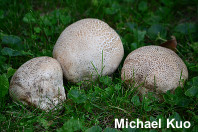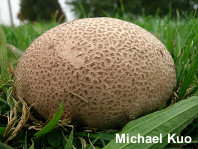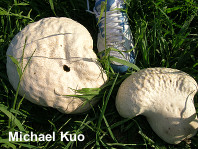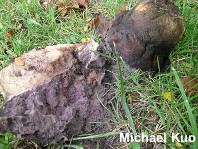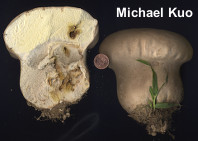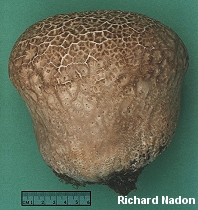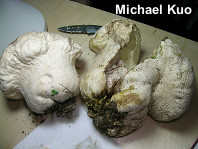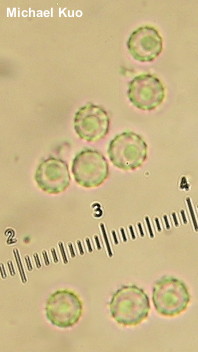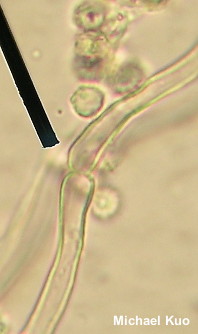| Major Groups > Puffballs > Calvatia cyathiformis |

|
Calvatia cyathiformis [ Basidiomycota > Agaricales > Agaricaceae > Calvatia . . . ] by Michael Kuo Typically between the size of a softball and a soccer ball at maturity, this widespread puffball is found in grassy areas. It is a very common fungus across much of our continent—but it is less common on the West Coast, where it is apparently replaced by the similar but smaller Calvatia fragilis. The epithet cyathiformis means "shaped like a flask," but I have trouble with that one. The species is usually shaped like a blob or a ball when young, and as it matures it begins to develop a basal portion that is a bit narrower than the ball-like portion, creating a shape vaguely reminiscent of an inverted pear or a loaf of bread. When sliced in half at this stage, the puffball's "sterile base" can easily be distinguished from the spore-filled "gleba," at first only texturally, but later by color, as the spores mature and the gleba becomes dark purple. The surface of the fungus can be fairly smooth and pale or, more commonly, brown and broken up into mosaic-like scales. Other large puffballs include Calvatia gigantea, which is smoother and whiter than most specimens of Calvatia cyathiformis and which lacks a sterile base—and Calvatia craniiformis, which usually features a dramatically narrowed sterile base and always has a yellow-brown, rather than purple, spore mass at maturity. Calvatia fragilis is virtually identical, but smaller, and with a less well-developed sterile base at maturity. Description: Ecology: Saprobic; growing alone, scattered, gregariously, or in fairy rings in grass (lawns, golf courses, parks, pastures, etc.); summer and fall; widely distributed in North America, but possibly absent on the West Coast. The illustrated and described collections are from Illinois and Québec. Fruiting Body: 8–17 cm high and 8–20 cm wide when mature; ball-shaped when young, but soon developing a thick basal portion that is slightly more narrow than the upper portion; at maturity usually shaped like an inverted pear or a loaf of bread. Outer Surface: Tan to pale brown; the pigment breaking up into small, mosaic-like scales; eventually becoming very pale brown to grayish or nearly white, with a vague mosaic of sections punctuated by brownish dots; dry; the skin 1–2 mm thick. Interior: White and firm when young; soon becoming two-chambered texturally, with the basal portion distinct from the upper portion; upper portion becoming yellowish and finally deep brownish purple as it matures and turns into spore dust; basal portion turning yellowish, then olive with age. Over-Mature Specimens: After the top ruptures and the spore mass is dispersed, the sterile base can remain, cup-like, with a ragged upper edge, for weeks. Odor and Taste: Not distinctive. Chemical Reactions: KOH negative on outer surface. Spore Dust: Purple. Microscopic Features: Spores 3–6 µm (including ornamentation); globose; covered with spines 0.5–1 µm long; hyaline in KOH; brownish in Melzer's reagent. Capillitial threads 2–5 µm wide; walls about 0.5 µm thick; hyaline in KOH; smooth or very minutely pitted; a little narrowed at septa. REFERENCES: (Bosc, 1811) Morgan, 1890. (Coker & Couch, 1928; Smith, 1951; Zeller & Smith, 1964; Morales & Kimbrough, 1978; Smith, Smith & Weber, 1981; Weber & Smith, 1985; Arora, 1986; States, 1990; Phillips, 1991/2005; Lincoff, 1992; Metzler & Metzler, 1992; Horn, Kay & Abel, 1993; Evenson, 1997; Barron, 1999; Baseia, 2003; Roody, 2003; Bates, 2004; McNeil, 2006; Miller & Miller, 2006; Bates et al., 2009; Kuo & Methven, 2014; Cripps, Evenson & Kuo, 2016; Evenson, 2016.) Herb. Kuo 10090307, 09100401, 09030503, 09030506, 07120802. 09271401. This website contains no information about the edibility or toxicity of mushrooms. |
© MushroomExpert.Com |
|
Cite this page as: Kuo, M. (2016, September). Calvatia cyathiformis. Retrieved from the MushroomExpert.Com Web site: http://www.mushroomexpert.com/calvatia_cyathiformis.html |
